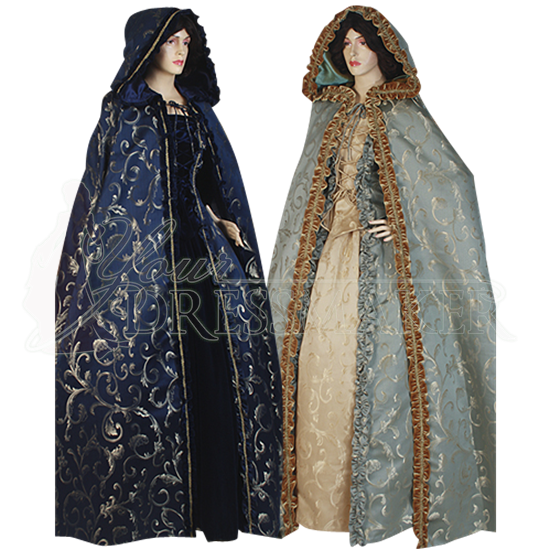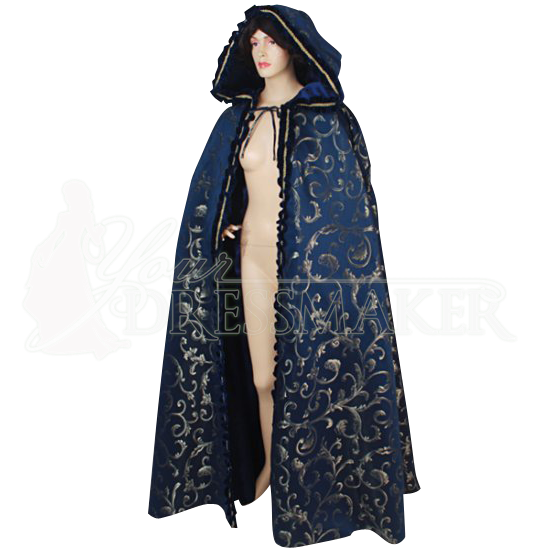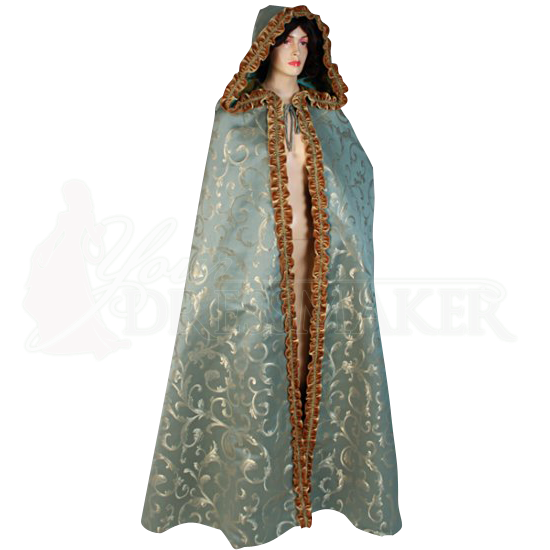Exploring The Rennaisance Cloak: Style, Status, And Stories From A Pivotal Era
Have you ever stopped to think about the stories a simple piece of clothing might tell? The rennaisance cloak, you know, it's more than just fabric draped around shoulders. It represents a whole era, a time of incredible change and artistic expression. This period, known as the Renaissance, was possibly the most important period of development that has ever occurred in European history, so it really makes sense that even the clothes from then carry such weight.
This cultural movement, spanning the 15th and 16th centuries, was a product of a much broader revival of craft and a revolution in creativity. It was, in some respects, a dramatic shift from the medieval mindset, moving towards a renewed focus on human potential and classical wisdom. The cloak, then, became a visual symbol of these profound shifts, reflecting new ideas about art and even science, you see.
We will explore the many facets of the rennaisance cloak, from its practical uses to its role as a statement of social standing. You will find out about the materials, the styles, and how these garments truly captured the spirit of a time that rediscovered ancient Greece and Rome. It's almost like stepping back in time to see how these pieces were worn, right?
Table of Contents
- What Was a Rennaisance Cloak, Really?
- The Renaissance: A Time of Rebirth and Its Impact on Dress
- Styles and Shapes: A Cloak for Every Occasion
- Materials and Craftsmanship: More Than Just Fabric
- Status and Symbolism: What Your Cloak Said About You
- The Rennaisance Cloak in Art and Everyday Life
- Bringing the Past to the Present: The Enduring Appeal
- People Often Ask About Rennaisance Cloaks
What Was a Rennaisance Cloak, Really?
When we picture a rennaisance cloak, many ideas might come to mind, you know? It wasn't just a simple blanket thrown over the shoulders. These garments were often quite elaborate, serving many purposes beyond just keeping someone warm. They were a key part of how people presented themselves in public, actually.
The Renaissance, a period immediately following the Middle Ages, saw a great revival of interest in the classical learning and values of ancient Greece and Rome, as a matter of fact. This renewed focus on antiquity influenced everything, even clothing styles. Cloaks, in a way, took on new forms that echoed some of those older classical designs, moving away from purely medieval shapes.
These outer garments could be long or short, open or closed, and were worn by people from all walks of life. They offered protection from the weather, certainly, but also provided a sense of modesty and, for some, a touch of dramatic flair. It was, you could say, a versatile piece of clothing, used for travel, ceremonial events, or just daily wear.
A rennaisance cloak was typically a loose-fitting outer garment, usually without sleeves, that covered the wearer's body. Some styles had slits for arms, or even short capes attached to the shoulders. The way it draped, you know, could really change how a person looked, making them appear grander or more modest, depending on the cut and fabric.
The design often reflected the wearer's position in society, which is something we'll get into a bit later. But even for ordinary people, a cloak was a necessary item, offering practical benefits in a time before modern heating or waterproof gear. It was, in short, a fundamental piece of the Renaissance wardrobe.
The Renaissance: A Time of Rebirth and Its Impact on Dress
The period we call the Renaissance was a cultural and scholarly movement, stressing the rediscovery and application of texts and thought from classical antiquity, occurring in Europe, you see. This was a time when new ideas about art and science were developed, and new technologies, like paper and gunpowder, were widely adopted. All these changes, naturally, found their way into how people dressed.
Spanning roughly from the 14th to the 17th century, it marked a dramatic shift from the medieval mindset to a renewed focus on human potential and artistic innovation. This shift meant that clothing became more than just functional; it became a form of artistic expression itself. The rennaisance cloak, then, was very much a part of this broader cultural awakening, reflecting the spirit of the age.
The revival of craft and a revolution in creativity, which characterized the Renaissance, meant that textiles became more sophisticated. Dyers experimented with richer colors, weavers created more intricate patterns, and tailors developed more complex cuts. This allowed for a greater variety in cloak styles, giving people more choices than they had before, you might say.
This was a period associated with great social change in most fields and disciplines, including art, architecture, politics, literature, exploration, and science. The impact on the art world, in particular, was immense, and clothing, too, became a canvas for personal and societal statements. A rennaisance cloak, therefore, often carried symbolic meaning, going beyond its simple function as an outer garment.
The interest in ancient Greece and Rome wasn't just about philosophy or architecture; it also influenced aesthetics. People started to appreciate the elegant draping seen in classical statues, and this elegance found its way into the design of cloaks. It was, quite literally, a rebirth of old ideas in new forms, which is fascinating, really.
Styles and Shapes: A Cloak for Every Occasion
The rennaisance cloak wasn't a single, unchanging item; its styles varied greatly across regions and over the centuries it was worn. You had, for instance, different cuts for men and women, and also different designs for various social standings. This variety meant there was, in some respects, a cloak for nearly every occasion.
For men, cloaks often featured broad shoulders and a full cut, sometimes reaching to the ankle. They could be open at the front, allowing a glimpse of the rich clothing underneath, or fastened with elaborate clasps. In Italy, for example, a shorter, more fitted cloak might have been common, while in northern Europe, longer, more voluminous styles were popular, you know.
Women's cloaks, too, showed a range of designs. Some were simple capes, perhaps with a hood, offering warmth and modesty. Others were grand, flowing garments, often lined with contrasting colors or furs, which added to their visual impact. These longer cloaks, very often, created an elegant silhouette, perfect for making a grand entrance.
There were also specific types of cloaks. The 'mantle' was a common term, often referring to a large, loose cloak. The 'houppelande,' popular earlier in the period, was a voluminous outer garment that could sometimes resemble a cloak with its wide sleeves and flowing lines. These names, you see, help us understand the subtle differences in their construction and wear.
The period's fashion saw changes in how cloaks were fastened as well. Some were simply held by hand, others secured with a brooch or a chain across the chest. Later styles might have incorporated more structured collars or even small capes attached to the main body of the cloak. It really shows a development in tailoring and design over time, doesn't it?
Regional differences played a big part, too. Venetian cloaks might have been lighter and more decorative, reflecting the city's trade connections and love for luxury. German cloaks, by contrast, might have been more practical and heavy, suited for colder climates. These variations highlight how local cultures shaped fashion, you know, even for something as universal as a cloak.
Materials and Craftsmanship: More Than Just Fabric
The materials used for a rennaisance cloak told a story all their own, reflecting the wearer's wealth and status, as a matter of fact. From humble wool to opulent silk velvet, the choice of fabric was very important. The cultural movement of the Renaissance, with its revival of craft, certainly influenced the quality and variety of textiles available.
Common people typically wore cloaks made from sturdy wool. This material was practical, offering warmth and protection from the elements. The wool could be dyed in various colors, though brighter, more expensive dyes were usually reserved for those with more money. A good wool cloak was, basically, a necessity for daily life.
For the wealthy, the options were far more luxurious. Velvet was a highly prized fabric, known for its rich texture and deep colors. Silk, too, was a sign of affluence, often imported from distant lands. These materials draped beautifully, catching the light in a way that plain wool simply couldn't, you know.
Lining a cloak was another opportunity to display wealth. Rich furs, like ermine or sable, were used by nobility, not just for warmth but as a clear symbol of their high standing. Even a silk lining, in a contrasting color, could add a touch of extravagance to a cloak, making it more impressive. It was, in some respects, about showing off a little.
Embellishments were also common. Embroidery, often with gold or silver thread, could adorn the edges or collars of a rennaisance cloak. Precious stones or pearls might have been sewn onto the fabric for truly grand pieces. These details, you see, turned a simple garment into a work of art, a testament to the skilled artisans of the time.
The craftsmanship involved in making these cloaks was quite remarkable. Tailors and seamstresses were highly skilled, creating garments that fit well and lasted. The revolution in creativity during the Renaissance meant that these artisans were constantly pushing boundaries, experimenting with new techniques and designs. You can learn more about a deeper look into historical garments and the artistry involved in their creation.
The quality of the fabric and the skill of the maker were, basically, inseparable from the cloak's overall appeal. A finely made rennaisance cloak was a statement of both personal taste and economic standing, a piece of wearable history that still captures our imagination today, you might say.
Status and Symbolism: What Your Cloak Said About You
During the Renaissance, clothing was a very clear indicator of a person's place in society. A rennaisance cloak, perhaps more than any other garment, served as a powerful symbol of status and wealth. What you wore on your back, you know, could speak volumes about who you were.
Sumptuary laws, which were rules about who could wear what, were common during this period. These laws dictated what colors, fabrics, and even types of fur different social classes were allowed to use. For example, purple was often reserved for royalty, and certain furs only for nobility. This meant that a cloak's appearance was, in some respects, legally regulated.
The sheer amount of fabric used in a cloak could also signal wealth. More voluminous cloaks, requiring more material, were naturally more expensive. A long, flowing rennaisance cloak made of fine wool or silk velvet, with a rich fur lining, would immediately identify the wearer as someone of considerable means. It was, basically, a walking advertisement of their status.
Colors held significant meaning, too. Bright, vibrant dyes were more costly to produce, so a cloak in a brilliant red or deep blue suggested a wealthy owner. More muted, earthy tones were common for those with less disposable income. The color of your cloak, therefore, could communicate your social standing at a glance, you see.
Beyond the fabric and color, embellishments played a big role. Gold embroidery, pearls, or even jeweled clasps on a rennaisance cloak were unmistakable signs of extreme wealth. These details were not just decorative; they were deliberate displays of luxury, meant to impress and differentiate. It was, quite literally, about making a statement with your attire.
Even the way a cloak was worn could convey meaning. A gentleman might drape his cloak over one shoulder with a certain flourish, suggesting confidence and elegance. A scholar, perhaps, would wear a simpler, darker cloak, reflecting their focus on learning rather than outward display. The cloak was, in short, a versatile tool for personal expression within the social norms of the time.
The connection between clothing and social hierarchy was a deeply ingrained part of Renaissance life. A rennaisance cloak was far from just a functional item; it was a carefully chosen piece of apparel that communicated identity, power, and position to everyone who saw it, you know.
The Rennaisance Cloak in Art and Everyday Life
The Renaissance, known primarily for its impact on the art world, left us with countless depictions of life during that time. Paintings, sculptures, and drawings often feature people wearing a rennaisance cloak, offering us a wonderful visual record of their appearance and how they were used. These artworks, you see, are like windows into the past.
Artists like Leonardo da Vinci, Michelangelo, and Raphael frequently included cloaked figures in their works. Looking at these paintings, you can observe the different styles, the way the fabric drapes, and the various colors and materials. A cloaked figure in a portrait often conveyed dignity or importance, adding a sense of gravitas to the subject, actually.

Womens Hooded Renaissance Cloak - MCI-354 by Medieval and Renaissance Clothing, Handmade

Womens Hooded Renaissance Cloak - MCI-354 by Medieval and Renaissance Clothing, Handmade

Womens Hooded Renaissance Cloak - MCI-354 by Medieval and Renaissance Clothing, Handmade